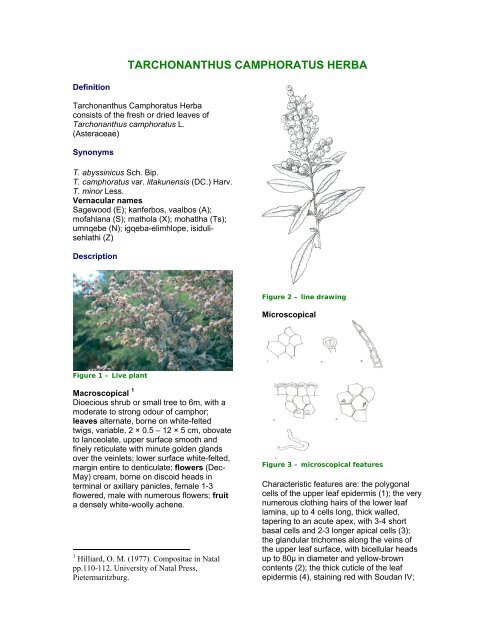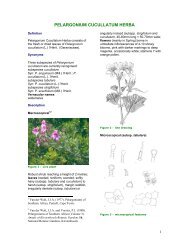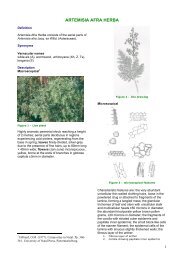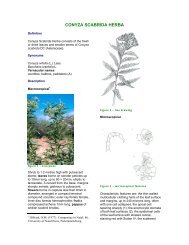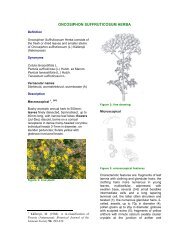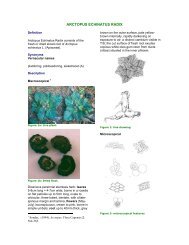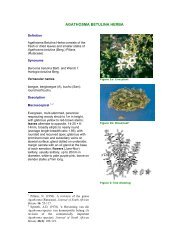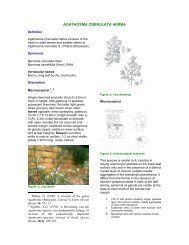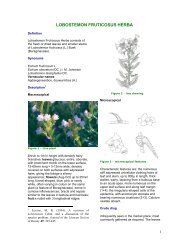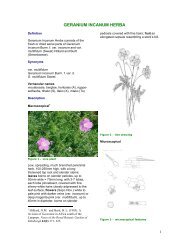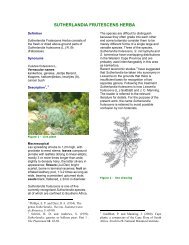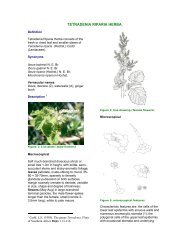TARCHONANTHUS CAMPHORATUS HERBA - PlantZAfrica
TARCHONANTHUS CAMPHORATUS HERBA - PlantZAfrica
TARCHONANTHUS CAMPHORATUS HERBA - PlantZAfrica
Create successful ePaper yourself
Turn your PDF publications into a flip-book with our unique Google optimized e-Paper software.
<strong>TARCHONANTHUS</strong> <strong>CAMPHORATUS</strong> <strong>HERBA</strong>DefinitionTarchonanthus Camphoratus Herbaconsists of the fresh or dried leaves ofTarchonanthus camphoratus L.(Asteraceae)SynonymsT. abyssinicus Sch. Bip.T. camphoratus var. litakunensis (DC.) Harv.T. minor Less.Vernacular namesSagewood (E); kanferbos, vaalbos (A);mofahlana (S); mathola (X); mohatlha (Ts);umnqebe (N); igqeba-elimhlope, isidulisehlathi(Z)DescriptionFigure 2 – line drawingMicroscopicalFigure 1 – Live plantMacroscopical 1Dioecious shrub or small tree to 6m, with amoderate to strong odour of camphor;leaves alternate, borne on white-feltedtwigs, variable, 2 × 0.5 – 12 × 5 cm, obovateto lanceolate, upper surface smooth andfinely reticulate with minute golden glandsover the veinlets; lower surface white-felted,margin entire to denticulate; flowers (Dec-May) cream, borne on discoid heads interminal or axillary panicles, female 1-3flowered, male with numerous flowers; fruita densely white-woolly achene.1 Hilliard, O. M. (1977). Compositae in Natalpp.110-112. University of Natal Press,Pietermaritzburg.Figure 3 – microscopical featuresCharacteristic features are: the polygonalcells of the upper leaf epidermis (1); the verynumerous clothing hairs of the lower leaflamina, up to 4 cells long, thick walled,tapering to an acute apex, with 3-4 shortbasal cells and 2-3 longer apical cells (3);the glandular trichomes along the veins ofthe upper leaf surface, with bicellular headsup to 80µ in diameter and yellow-browncontents (2); the thick cuticle of the leafepidermis (4), staining red with Soudan IV;
the parenchyma of the leaf mesophyllcontaining bundles of minute calciumoxalate raphides (5).Crude drugBundles of fresh or dried materialcomprising leafy twigs; texture coarseleathery,colour grey-green, odour faintcamphoraceous.Geographical distributionFigure 5 – TLC plateHPLC on C 18 column, method according toAppendix 2b.Figure 4 – distribution mapMajor compounds:Methanol extract: (figure 6a)Retention times (mins): 10.72; 18.17; 18.93;20.54; 20.78; 26.15; 26.66Widespread in all provinces of South Africa,in coastal forest, thornveld and thicket; alsoin Lesotho, Swaziland, Namibia, and northinto tropical Africa.Quality standardsIdentity testsThin layer chromatography on silica gelusing as solvent a mixture of toluene:diethylether:1.75M acetic acid (1:1:1). Referencecompound cineole (0, 1% in chloroform).Method according to Appendix 2a.R f values of major compounds: 0.18(indigo); 0.59 (grey-mauve); 0.72 (greymauve);0.80 (grey); 0.95 (purple); cineole:0.83 (purple)Figure 6 a – MeOH HPLC spectrumFigure 6 b – DCM HPLC spectrumDCM extract: (figure 6b)
Retention times (mins): 1.29; 2.20; 4.37;4.51; 5.64Ethanol (70%) soluble extractive value: notless than 21.7% (range: 21.74-29.82%)Purity testsAssayNot yet availableMajor chemical constituentsDosage formsThe leaves of Tarchonanthus camphoratusare utilised in a number of ways: infusions,tinctures or decoctions are taken orally andthe vapours from burning green materialeither inhaled or directed as a fumigant toinflamed joints; fresh leaf may chewed orsmoked; a leaf poultice may be applied tothe chest and an ointment to affected areas.Medicinal usesDespite its wide geographical distribution,the medicinal uses to which this species isput are remarkably similar throughout itsrange. It is taken orally or applied externallyto relieve bronchitis, asthma, headache,inflammation, chilblains or abdominal pains.Leaf infusions have also been reported to bediaphoretic.Pharmacology/bioactivityFigure 7 – chemical constituentsPhytochemical tests in our laboratoriesindicated the presence of tannins, saponins(2/3 collections) and reducing sugars (2/3collections), but not of alkaloids, nor ofcardiac or anthraquinone glycosides.Analyses of the leaf oil (yield: 0.76%V/W) ofKenyan plants identified α-fenchyl alcohol(29.1%), 1,8-cineole (eucalyptol: 16.5%) andα-terpineol (8.5%) as the major constituents.Camphor was present in only minor quantity(0.4%) 2 . Various flavones (e.g. luteolin,apigenin, nepetin and hispidulin) have beenidentified in Egyptian collections of thisspecies, as has the sesquiterpene lactoneparthenolide as well as a quaternaryalkaloid, tarchonanthine. 3No in vitro activity against Staphylococcusaureus, Pseudomonas aeruginosa, Candidaalbicans or Mycobacterium smegmatis wasshown by aqueous leaf extracts used inpreliminary assays for antimicrobial activityin our laboratories.A more recent investigation of antimicrobialactivity of aqueous, ethanolic and hexaneextracts of dried leaf did not demonstrate in vitroinhibitory effects against Staphylococcus aureus,Bacillus subtilis, Escherichia coli or Klebsiellapneumoniae. 4Aqueous leaf extracts administered i. p. tomice at a dose of 50-100mg/kg were shownto significantly attenuate pain in the aceticacid writhing test. At a dose of 100mg/kg,pain was significantly antagonised in the hotplate test. The same study was able todemonstrate that an aqueous extract(100mg/kg) significantly reduced feverinduced in the rat by bacterial endotoxin. 52 Mwangi, J.W., Achola, K.J. et al. (1994).Volatile constituents of the essential oil ofTarchonanthus camphoratus L. Journal ofEssential Oil Research 6: 183-185.3 Bishay, D.W., Attia, A.A. and Fayed, M.A.(2002). Flavones and a quaternary alkaloid fromTarchonanthus camphoratus L. Bull. Pharm. Sci.Assiut Univ. 25(1): 1-6.4 McGaw, L.J., Jager, A.K. and van Staden, J.V.(2000). Antibacterial, anthelmintic and antiamoebicactivity of South African medicinalplants. Journal of Ethnopharmacology 72(1/2):247-263.5 Amabeoku, G.J., Green, I., Eagles, P. andBenjeddou, M. (2000). Effects of Tarchonanthuscamphoratus and Eriocephalus africanus on
ContraindicationsNone knownAdverse reactionsNone recordedPrecautionsNo special precautionsDosageTo be determinedCopyright in this monograph resides with the authors, the SouthAfrican National Biodiversity Institute, the South African MedicalResearch Council and the University of the Western Cape. It maynot be reproduced in whole or in part without the written consent ofthe copyright holders.nociception in mice and pyrexia in rats.Phytomedicine 7(6): 517-522


